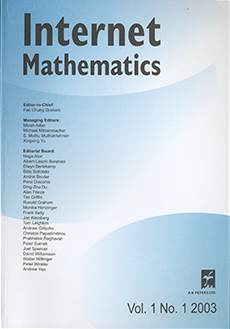Abstract
This paper studies the expansion properties of randomly perturbed graphs. These graphs are formed by adding, for example, a random $1$-out or very sparse Erdős-Rényi graph to an arbitrary connected graph.
The central results show that there exists a constant $\delta$ such that when any connected $n$-vertex base graph $G_0$ is perturbed by adding a random $1$-out then, with high probability, the resulting graph has $e(S,\bar S) \geq \delta |S|$ for all $S\subseteq V$ with $|S| \leq \frac34 n$. When $G_0$ is perturbed by adding a random Erdős-Rényi graph, $\mathbb{G}_{n,e/n}$, the expansion of the perturbed graph depends on the structure of the base graph. A necessary condition for the base graph is given under which the resulting graph is an expander with high probability.
The proof techniques are also applied to study rapid mixing in the small-worlds graphs described by Watts and Strogatz in Watts and Strogatz, 1998 and by Kleinberg in Kleinberg, 2000. Analysis of Kleinberg's model shows that the graph stops being an expander exactly at the point where a decentralized algorithm is effective in constructing a short path.
The proofs of expansion rely on a method of summing over subsets of vertices that allows an argument based on the first-moment method to succeed.
Citation
Abraham D. Flaxman. "Expansion and Lack Thereof in Randomly Perturbed Graphs." Internet Math. 4 (2-3) 131 - 148, 2007.
Information




